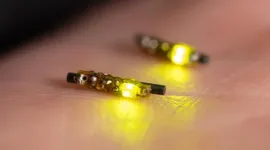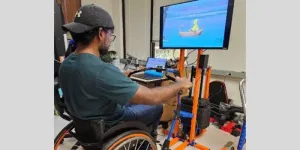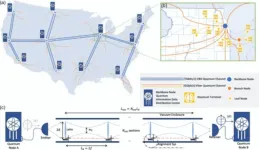(Press-News.org)
Certain types of light have proven to be an effective, minimally invasive treatment for cancers located on or near the skin when combined with a light-activated drug. But deep-seated cancers, surrounded by tissue, blood and bone, have been beyond the reach of light’s therapeutic effects.
To bring light’s benefits to these harder-to-access cancers, engineers and scientists at the University of Notre Dame have devised a wireless LED device that can be implanted. This device, when combined with a light-sensitive dye, not only destroys cancer cells, but also mobilizes the immune system’s cancer-targeting response. The research was published in Photodiagnosis and Photodynamic Therapy.
“Certain colors of light penetrate tissue deeper than other ones,” said Thomas O’Sullivan, associate professor of electrical engineering and co-author on the paper. “It turns out that the kind of light — in this case green — that doesn’t penetrate as deeply has the capability of producing a more robust response against the cancer cells.”
Before the light can be effective in destroying cancer cells, a dye with light-absorbing molecules must be administered to the cells. The device turns on, the dye transfers the light into energy and that energy makes the cells’ own oxygen toxic — in effect, turning the cancer cells against themselves.
While other treatments also weaponize the cells’ own oxygen, this device causes a particularly serendipitous form of cell death.
“Working together, biochemistry graduate student Hailey Sanders and electrical engineering graduate student SungHoon Rho perceptively noted that the treated cells were swelling, which is the hallmark of a kind of cell death, pyroptosis, that’s particularly good at triggering the immune response,” said Bradley Smith, the Emil T. Hofman Professor of Science and co-author on the paper.
“Our goal is to induce just a little bit of pyroptotic cell death, which will then trigger the immune system to start attacking the cancer.”
In future studies, the device will be used in mice to see whether the cancer-killing response initiated in one tumor will prompt the immune system to identify and attack another cancerous tumor on its own.
O’Sullivan noted that the device, which is the size of a grain of rice, can be injected directly into a cancerous tumor and activated remotely by an external antenna. The goal is to use the device not only to deliver treatment but also to monitor the tumor’s response, adjusting signal strength and timing as needed.
This research was one of four projects funded by the first Seed Transformative Interdisciplinary Research (STIR) grants. Initiated in 2023 by the Notre Dame College of Science and College of Engineering, these grants are designed to jump-start science and engineering research projects in human health, the environment and information technologies.
END
Implantable LED device uses light to treat deep-seated cancers
2024-07-09
ELSE PRESS RELEASES FROM THIS DATE:
LA County faces dual challenge: Food insecurity and nutrition insecurity
2024-07-09
While food insecurity has long been the focus of local and national policymakers and researchers, nutrition insecurity has largely been overlooked. A new study by the Institute for Food System Equity (IFSE) at the USC Dornsife College of Letters, Arts and Sciences aims to change that.
This is the first study in Los Angeles County to identify the populations most affected by nutrition insecurity, distinct from food insecurity. Nutrition insecurity refers to a lack of access to healthy food that ...
AI can support humanitarian organizations in situations of armed conflict or crisis - but they should understand the potential risks, study warns
2024-07-09
AI can help humanitarians gain crucial insights to better monitor and anticipate risks, such as a conflict outbreak or escalation. But deploying systems in this context is not without risks for those affected, a new study warns.
Humanitarian organisations have been increasingly using digital technologies and the Covid-19 pandemic has accelerated this trend.
AI-supported disaster mapping was used in Mozambique to speed up emergency response, and AI systems were used to predict food crisis and rolled out by the World Bank across twenty-one countries.
But the study warns some uses of AI may expose people to additional harms and present significant ...
Speech Accessibility Project’s three newest partners are dedicated to people with cerebral palsy
2024-07-09
The Speech Accessibility Project is partnering with several organizations who serve people with cerebral palsy as it recruits more participants for its speech recognition technology work. They include ADAPT Community Network, the Cerebral Palsy Foundation and CP Unlimited.
The project is recruiting U.S. and Puerto Rican adults with cerebral palsy, amyotrophic lateral sclerosis, Down syndrome, Parkinson’s and those who have had a stroke. Funded by Big ...
UT Arlington increases interdisciplinary grants by 40% in 2024
2024-07-09
The Office of the Vice President for Research and Innovation at The University of Texas at Arlington has awarded seven Interdisciplinary Research Program (IRP) grants totaling nearly $140,000 to foster collaboration between groups that do not typically work together. This represents an increase in funding of 40% over the grants awarded in 2023.
“UT Arlington has increased its support of interdisciplinary research as we know that many of today’s great societal challenges ...
MIT researchers introduce generative AI for databases
2024-07-09
CAMBRIDGE, MA — A new tool makes it easier for database users to perform complicated statistical analyses of tabular data without the need to know what is going on behind the scenes.
GenSQL, a generative AI system for databases, could help users make predictions, detect anomalies, guess missing values, fix errors, or generate synthetic data with just a few keystrokes.
For instance, if the system were used to analyze medical data from a patient who has always had high blood pressure, it could catch a blood pressure reading that ...
Exponentially increasing understanding of early life on Earth
2024-07-09
Despite decades of research, there’s still much scholars don’t understand about life’s beginnings and early evolution. A UC Riverside paper has opened the door to understanding more and to framing future studies that could help predict climate change and search for life beyond Earth.
“This paper strives to inform the Earth sciences community where the research needs to go next,” said Christopher Tino, a UCR PhD candidate during the time of research and a first author.
Many studies have explored signs ...
New method could yield fast, cross-country quantum network
2024-07-09
Quantum computers offer powerful ways to improve cybersecurity, communications, and data processing, among other fields. To realize these full benefits, however, multiple quantum computers need to be connected to build quantum networks or a quantum internet. Scientists have struggled to come up with practical methods of building such networks, which must transmit quantum information over long distances.
Now, researchers at the University of Chicago Pritzker School of Molecular Engineering (PME) have proposed a new approach — building long quantum channels using vacuum sealed tubes ...
Aging retinal pigmented epithelium: Omics-based insights into vision decline
2024-07-09
“These findings potentially support employing anti-aging therapies such as senolytic pharmacologic compounds to prevent or ameliorate progression to AMD [...]”
BUFFALO, NY- July 9, 2024 – A new editorial paper was published in Aging (listed by MEDLINE/PubMed as "Aging (Albany NY)" and "Aging-US" by Web of Science) Volume 16, Issue 12, entitled, “Aging retinal pigmented epithelium: omics-based insights into vision decline.”
In this new editorial, researchers Ioan V. Matei and Luminita Paraoan from ...
Public health researchers detail way forward post-pandemic
2024-07-09
AURORA, Colo. (July 9, 2024) – In the aftermath of the COVID-19 pandemic, the U.S. public health system must focus on critical questions of accountability, politicization and updating data systems if it is to do its job well and maintain the trust of the American people, according to a new report from the Colorado School of Public Health.
The report, authored by Professor Jonathan Samet, MD, MS, of the Colorado School of Public Health and Professor Ross Brownson, PhD, of Washington University in St. Louis, was published recently in the journal Health Affairs.
In ...
Improving 'health span' through slowing age-related cognitive decline
2024-07-09
Two University of Oklahoma researchers have been awarded more than $2 million in grants from the Hevolution Foundation to further their studies on age-related cognitive impairment, with an emphasis on improving “health span,” or the number of years a person remains healthy.
While modern medicine can help extend a person’s life span, researchers are increasingly studying ways to increase their healthy years of life. Because the process of aging increases the risk for memory problems and dementia, researchers must understand why as a first step toward delaying cognitive issues until later in life. The Hevolution Foundation ...







